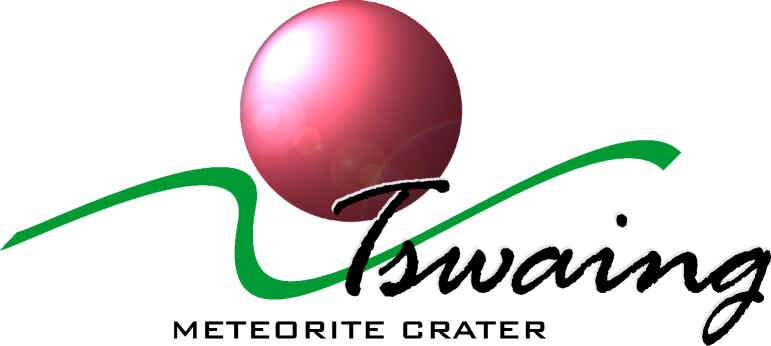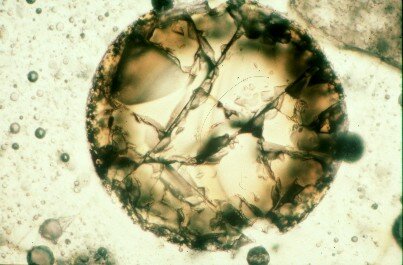|
Spherical particle of impact glass found 89 m below crater floor (courtesy Department of Geology, University of the Witwatersrand) |
 |
|
Solving The Riddle Of Tswaing's Origin |
|
| After the drill core from the centre of the crater became available for detailed analysis, a first series of samples from the bottom of the core, where it intersects the basement granite, were subjected to microscope analysis. None of these samples contained any mineral deformation that could have been the result of the enormous pressures and temperatures related only to impact metamorphism. In 1990, Professor Uwe Reimold of the Department of Geology, University of the Witwatersrand, who was a member of the research team, concluded reluctantly that an origin by some kind of process from the interior of the earth could not be excluded. Not having direct evidence for the cause of the cratering event was unsatisfactory. It was then decided that the remaining part of the drill core, representing the sediments between the post-cratering sections and the granite at the base, had to be further analysed. Large amounts of this sandy material were collected and grain mounts, i e thin sections of many individual grains, were made. The first section was placed under the microscope, and only ten minutes later the first shock-metamorphosed quartz grain, with multiple sets of planar deformation features, had been identified. This was just one of the many more found in every sample of the material from the intermediate sections of the drill core. A large number of spherical, ovoid and dumb-bell shaped glass fragments were also observed and analysed with a micro analyser, known as an electron microprobe, which enables the chemical composition of small spots in individual mineral grains to be determined. It was discovered that these glass fragments and droplets had formed as the result of the melting or partial melting of individual mineral grains (quartz, feldspar, amphibole and biotite), or combinations of different minerals that are the principal constituents of the Nebo Granite. Diaplectic quartz and feldspar glass were also found, in effect plentiful evidence of shock metamorphism. This meant that the impact origin of the Tswaing Crater was finally established. The crater sediments were identified as an unconsolidated package of suevitic breccia - impact-fragmented material that contains some glass/melt material. The drill core also allowed for the reconstruction of a complete cross-section through the impact crater. In the course of his BSc Honours and MSc studies at the University of the Witwatersrand, Dion Brandt mapped the whole area and confirmed that volcanic rocks occur throughout the region and are not confined to the crater only. The age of some of these rocks had been determined to be about 1 300 million years. When large numbers of glass particles were identified in the drill core, it was decided to try the fission-track age-dating method. When uranium atoms in a material undergo radioactive decay, the daughter products of this process form tiny, microscopic tracks (fission tracks). The more fission tracks there are in an area in a thin section, the more time has passed since decay began. Over 400 glass particles were separated from the sandy breccia and subjected to chemical analysis to determine the uranium concentrations. The fission tracks were counted and measured under a high magnification microscope by Dieter Storzer in Paris, France. The result showed that the glass was formed only about 220 000 years ago, which is much younger than the age of 1 300 million years for the volcanic rocks of the region. Within the error limits of the fission-track results, the age for the Tswaing Crater is 220 000 years. This result also confirmed the extrapolated radiocarbon age for the sediments of the drill core. |
|
| (Source: REIMOLD, W U, BRANDT, D, DE JONG, R C, HANCOX, J, 1999, Tswaing Meteorite Crater. An introduction to the natural and cultural history of the Tswaing region including a description of the hiking trail. Popular Geoscience Series 1. Pretoria: Council for Geoscience. Available at the Council for Geoscience, Pretoria, South Africa) | |
| All intellectual property rights, including but not limited to copyright and trademarks, vested in the material contained on the NFI website is held by the NFI and may not be copied, reproduced, adapted, published or distributed in any form whatsoever without the prior written consent of the responsible person at the NFI. | |
